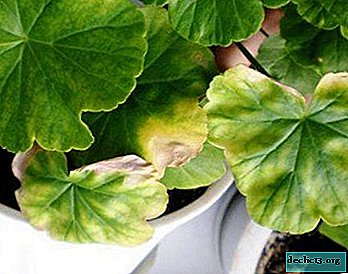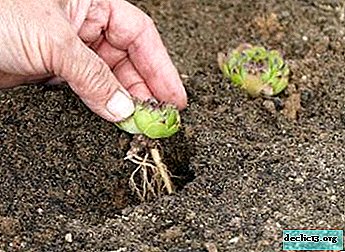Beautiful flower of Spathiphyllum Picasso: photo, features of care and growing

Spathiphyllum Picasso is not only completely safe - it does not cause allergies, but can also heal and decorate any home.
Spathiphyllum Picasso is an indoor flower, capable of safely growing and developing even in the absence of natural light. Due to its unusual shape, the plant acquired the name “female happiness”. And such a name is justified, because the flower does not require much effort and time to care for it.
Instructions for the proper care of the flower, its propagation and possible problems, as well as a selection with photos are presented in the article.
A brief definition of this type
Spathiphyllum Picasso belongs to the perennial evergreen flowers of the Aroid family. In the natural environment, this species grows in Central and South America - El Salvador, Mexico, can also be found in the Philippines and Brazil.
Habitat - the humid climate of swamp forests, coastal rivers and lakes. There are a large number of varieties of spathiphyllum varieties, among them - Picasso spathiphyllum.
Detailed description
Picasso is a hybrid from the Netherlands, derived from Wallis spathiphyllum. Its height reaches 40 - 50 cm. There are no stems in the spathiphyllum of Picasso, basal leaves form a basal rosette at the base.
The leaves are wide, long, up to 18 - 23 cm, shiny, medium in density at the ends are pointed. Coloring - bright green sectors of the leaf are mixed with white areas. Petioles are long, flexible.
The flower’s canvas itself has the shape of a sail, delicately white with a green scattering of spots, the ear is light yellow. The root is short.
History of occurrence
This tropical flower was discovered in the 19th century, by a scientist from Germany Wallis. Spathiphyllum translates as "cover - leaf", has a huge flower, similar to a waving sail. In the middle of the last century, breeders of Europe and America carried out work to develop unpretentious flower hybrids.
What is the difference from the rest of the species?
The main difference between the Picasso variety is the extravagant coloring of the leaves: green spots are mixed with large white spots. The potted Picasso variety is distinguished by the sparseness of the bush and special unpretentiousness in the care.
Spathiphyllum Picasso - does not drop foliage for the winter, it is an evergreen flower.Subsorta and their photos
Variegated

The height of the flower is 40-60 cm. The leaves are large, wide, light green and have a light longitudinal strip, a vein in the center of the leaf. It has a special aroma. The flower itself is wide, curved, with a sharp end, has a thick - white color. The core is an ear of pale yellow or cream color.
Dominoes

A rare hybrid, very unpretentious, is distinguished by the diversity of leaves. In height reaches no more than 30 - 40 cm, even in adulthood. Leaves are oblong, pointed at the ends, slightly wavy, curly, medium density, shiny.
Coloring: spots and strokes on the entire surface of the sheet plate are randomly arranged on the bright green background of the sheet. The flowers are fragrant, gracefully curved, spiky. The color is pale white, the ear is hairy, pale yellow.
Bloom
When and how?
Spathiphyllum Picasso only blooms with proper care. Blooms in early May, flowering lasts 3 weeks. Sometimes this variety can bloom repeatedly in the fall.
Care before and after
During the ripening of buds, good lighting and abundant watering are necessary. Once the flowers have wilted, they are cut off at the very base. During flowering and immediately after transplantation, Picasso spathiphyllum is not recommended to fertilize.
What to do if it does not bloom?
Lack of flowering indicates improper care. Perhaps the flower has been planted in an oversized pot. The diameter of the pot should be only 1.5 - 2 cm larger than the root.
 With a constant lack of light, inflorescences do not form. It should include additional lighting for 2 to 3 hours, or rearrange the pot in a lighter place.
With a constant lack of light, inflorescences do not form. It should include additional lighting for 2 to 3 hours, or rearrange the pot in a lighter place.- The lack of moisture in the substrate also inhibits flowering.
- Perhaps the presence of fungal infections and pests interfere with flowering. Prevention should be carried out - spraying with special solutions - insecticides.
Step-by-step care instructions
Seat selection
Spathiphyllum Picasso is very photophilous, he needs bright, but indirect, diffused sunlight. Typically, pots are placed in the southeast, if the flower grows on the southern window sills, a slight dimming of the windows is required. In autumn and winter, additional lighting is required for several hours a day.
Important: excess light can cause overheating of the substrate, leaves will become lethargic and lifeless, a lack of light reduces the number of peduncles, leaves are extended.What should be the soil?
The soil should be light, breathable, loose, fertilized and moist. The composition of the substrate for spathiphyllum Picasso:
- high peat;
- pine bark;
- river sand;
- 1: 1: 1 ratio.
As drainage, pebbles, expanded clay, expanded polystyrene, and crumb brick can be used. It is desirable to add crushed fallen leaves, coniferous litter, charcoal, granules of superphosphate to the substrate.
Landing
Planting is carried out in the spring, before flowering. Planting pattern of the spathiphyllum Picasso:
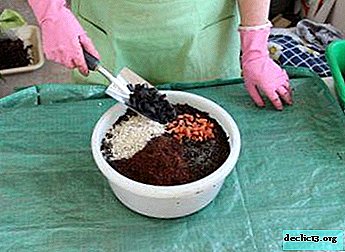 At the bottom of the pot have a 1.5 - 2 cm layer of drainage.
At the bottom of the pot have a 1.5 - 2 cm layer of drainage.- A special substrate is poured onto ½ part of the volume of the pot.
- Gently spread the roots throughout the space, slightly press the root processes.
- The remaining substrate is poured, rammed.
- Abundantly watered.
- Add soil to the pot during sludge after watering.
- Leaves moisturize well by spraying.
- For 4 to 5 days, the seedling is kept under a plastic cap.
Temperature
Spathiphyllum Picasso is a heat-loving flower, lowering the temperature to 10 ° C can cause root diseases or death of the flower itself. The optimum temperature of the content is 20 - 22 ° С. In summer, spraying is mandatory, it reduces the temperature by several degrees.
Watering
Spathiphyllum Picasso is very hygrophilous; at any time of the year, the substrate must be moist. It is necessary to monitor the humidity in the room, it should be 40 - 50%.
Every day in the summer, small bush irrigation is required. Once a week, you should wipe the leaves with a wet swab from dust, this procedure refreshes the flower, prevents disease. In summer, water the flower 3 times a week, abundantly. In winter, watering is limited, watering should be necessary, once a week.
Top dressing
In the spring and summer, intensive dressing is required for the Picasso spathiphyllum. It is better to use mineral complex fertilizers purchased in the store. Fertilizers are applied in small doses - 1-1.5 g per liter of water. Top dressing is carried out simultaneously with watering, so that fertilizers reach the root.
During flowering, flower fertilizer stops. Before flowering, potash - phosphorus fertilizers are used, 1: 1. At home, you can fertilize the substrate with organic fertilizers - diluted bird droppings.
Pruning
With the disease of spathiphyllum Picasso, it is required to cut neglected painful areas. After flowering, the peduncle is cut, dry leaves are also cut on time. When transplanting, dry and infected parts of the rhizome are necessarily cut out. To prevent infection, the cut sites are treated with crushed charcoal.
Transfer
It is advisable to transplant Picasso spathiphyllum in early spring. A transplant is needed if the pot has become small, the roots have grown, the flower has stopped blooming.
Attention: the root is fragile in structure, so it is better to use a safe transshipment method.Transplantation is carried out in several stages:
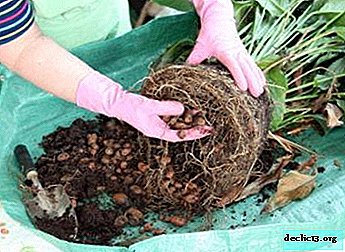 Soaked substrate in the old with a planting bush.
Soaked substrate in the old with a planting bush.- Removes excess earth from the root.
- Rotten roots are cut, slices are processed.
- At the bottom of the pot have a drainage layer, 1.5 - 2 cm.
- Put the flower in a pot, leaving an earthen lump.
- The void is filled with a substrate.
- Moderate watering is required, since the earthen lump is already well soaked.
- For 5-6 days, cover the pots with foil, regularly ventilating the temporary greenhouse.
Transplant roots should not be too deep. When rooted, they will serve as an additional support for the flower.
Watch the video about plant care:
How to propagate?
The peculiarity of the structure of Picasso spathiphyllum is the absence of a stem, the leaves are grouped in bunches, so at home this flower propagates by dividing the bush. They divide the bush every year, in the spring.
- Remove the flower from the old pot, after soaking the pot in water.
- Dry and infected parts of the root are cut out.
- Places of cuts are treated with charcoal.
- Directly divide the bush.
- Each separated seedling should have 3 leaf rosettes and part of the rhizome.
- At the bottom lay out the drainage.
- The seedling is placed shallow.
- Fall asleep with a special substrate.
- Abundantly watered.
Diseases and Pests
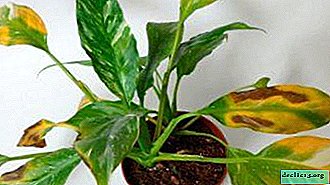 Spathiphyllum Picasso may be affected by a mealybug. Spraying once a week with a phytoderm will help. The procedure should be repeated 2 to 3 times for prevention. You can wash the leaves with soap and water, and remove the insects with a cotton swab.
Spathiphyllum Picasso may be affected by a mealybug. Spraying once a week with a phytoderm will help. The procedure should be repeated 2 to 3 times for prevention. You can wash the leaves with soap and water, and remove the insects with a cotton swab.- From spider mites, leaf treatment with a soap solution with the addition of nicotine - sulfate is necessary. In this case, you need to cover the soil with a film, leave the treated leaves for 12 - 15 hours, and then rinse with clean water. The procedure is repeated 2 to 3 times every week.
Prevention of various problems
- Various rot form when the flower is in a cold damp room and receives too much moisture. It is required to change the substrate, to clean the flower from the affected areas.
- If the tips of the leaves turn brown, it is necessary to moisten the air, add spraying. The reason may be drafts and stale air.
- From hard water or from sunburn, the leaves may turn yellow.
Spathiphyllum Picasso, like any indoor flower, needs care and attentive care, then he will thank with an extravagant view of the bush and extraordinary flowering.

 With a constant lack of light, inflorescences do not form. It should include additional lighting for 2 to 3 hours, or rearrange the pot in a lighter place.
With a constant lack of light, inflorescences do not form. It should include additional lighting for 2 to 3 hours, or rearrange the pot in a lighter place. At the bottom of the pot have a 1.5 - 2 cm layer of drainage.
At the bottom of the pot have a 1.5 - 2 cm layer of drainage. Soaked substrate in the old with a planting bush.
Soaked substrate in the old with a planting bush. Spathiphyllum Picasso may be affected by a mealybug. Spraying once a week with a phytoderm will help. The procedure should be repeated 2 to 3 times for prevention. You can wash the leaves with soap and water, and remove the insects with a cotton swab.
Spathiphyllum Picasso may be affected by a mealybug. Spraying once a week with a phytoderm will help. The procedure should be repeated 2 to 3 times for prevention. You can wash the leaves with soap and water, and remove the insects with a cotton swab.






